Explore Friuli Venezia Giulia with GoTravelDaily
Hidden in the far northeastern corner of Italy, the region of Friuli Venezia Giulia has been a crossroads for centuries. Bordered by Austria and Slovenia, the region stretches from the Alps and the Dolomites in the north to the Adriatic Sea almost an hour’s drive to the south, where populations from the Romans to the Austro-Hungarians have left their mark on its cultural and artistic heritage.
The result of these diverse terrains and cultural influences is a complex mosaic of opportunities – everything travelers love about Italy in one compact and easy-to-travel region. Join us as we hit the road in this under-the-radar region for a week of natural beauty, historic sites, and gastronomic delights.
Day 1 – Capital City Splendor
Start your trip in Friuli Venezia Giulia’s capital city, Trieste, on the Adriatic Sea. Here, stately neoclassical buildings reflect the region’s Austro-Hungarian past.
Today, Trieste is a melting pot of influences from its neighboring borders and centuries of Hapsburg heritage. Wander through the city, marveling at the varied architecture, and take in the sweeping views from Castello di San Giusto.
When you’re ready for a break, visit a café. Don’t rush it – locals in Trieste enjoy their coffee leisurely, consuming more coffee than any other population in Italy.
In the afternoon take the bus to Castello Miramare, a 19th-century Hapsburg residence in a stunning seaside location, complete with ornate decor and manicured gardens.
Day 2 – Roman History & Beach Time
Rent a car and drive west to Aquileia, once one of the largest cities of the Roman Empire and now a UNESCO-listed site. Much of the ancient ruins are visible today. The Museo Archeologico Nazionale offers a comprehensive overview of the former city and information about Roman life at that time.
The highlight in Aquileia is the Basilica di Santa Maria Assunta, which contains one of the largest mosaic floors still visible from Roman times. Visitors can marvel at the early Christian art, including detailed human faces, sea life, and Old Testament stories.
After visiting Aquileia, escape for an afternoon at one of Friuli Venezia Giulia’s beaches along the Adriatic Sea. Grado is a historic spa town with expansive beaches, ideal for a relaxing stroll.
Lignano Sabbiadoro is another sun-drenched option, popular for its large marina and picturesque beaches. The peninsula is bordered by the Adriatic Sea, the Tagliamento River, and a lagoon, recognized for its rich forestry.
Day 3 – Wine Country
Leave the beach for Friuli Venezia Giulia’s renowned Collio wine region. On your way, stop at Palmanova, a fortress city designed as a nine-pointed star. A walk through this UNESCO site reveals a fascinating example of Renaissance architecture.
As you enter Collio, enjoy its picturesque vineyards, where local producers create high-quality white wines. Savor a chilled glass of Friulano, Ribolla Gialla, or Istrian Malvasia while admiring the stunning countryside.
Day 4 – Historic Cities and Gastronomic Delights
Spend the morning in Udine, known for its gastronomic delights and rich cultural history. Once part of the Venetian Republic, Udine boasts famous frescoes by Tiepolo and Venetian design in the main Piazza della Libertà.
Try local Friulian cuisine, including frico (potato and cheese dish) and cjarsons (stuffed pasta). Don’t miss the noteworthy prosciutto from San Daniele, famous across Italy.
In the afternoon, explore Cividale del Friuli, a picturesque town with a well-preserved medieval center, recognized for its Lombard art and architecture.
Day 5 – Medieval & Renaissance Artistry
Italy has a rich tradition of mosaic art, and the Scuola Mosaicisti del Friuli in Spilimbergo continues this legacy. Founded over 100 years ago, students gather to study Roman and Byzantine mosaic traditions and apply their skills in diverse art projects.
Alongside mosaics, Spilimbergo features notable Renaissance-era art, including the frescoed exterior of Palazzo Dipinto. For more historic charm, visit Valvasone, a walled medieval village with a 12th-century castle.
Day 6 – Natural Adventures
The northern part of Friuli Venezia Giulia is abundant with mountain peaks and lakes. Travelers can choose from adventures in three mountainous zones.
The Friulian Dolomites are a UNESCO World Heritage Site, ideal for hiking and exploring turquoise rivers. The Carnic Alps feature renowned villages and peaks, with Sauris famous for its preserved pork and craft beer.
Monte Zoncolan is a well-known peak for summer cycling, trekking, and winter skiing, thanks to its accessible tram service. The Julian Pre-Alps offer a spectacular environment for trekking along the Alpe Adria Trail, suitable for both single and multi-day excursions.
Ultimately, Friuli Venezia Giulia is a paradise for both summer sports enthusiasts and winter adventurers. Each segment of this enchanting region, filled with diverse landscapes and rich history, promises an unforgettable experience for every traveler.





